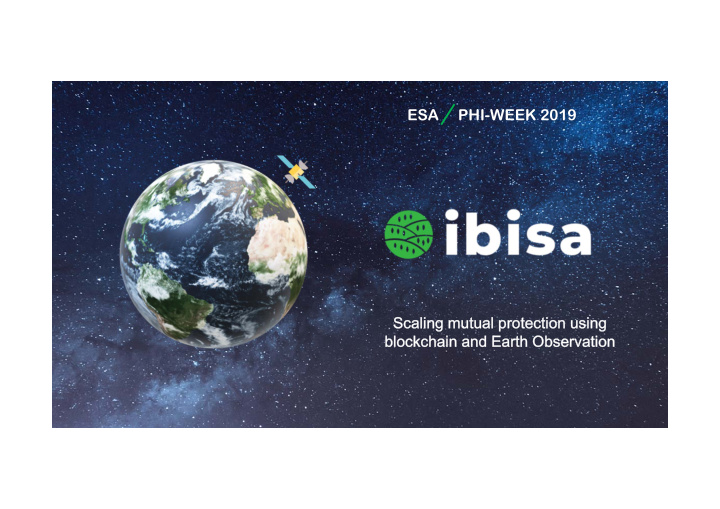



ESA PHI-WEEK 2019 Scaling mutual protection using blockchain and Earth Observation
The pain(s) – facts from IFAD, 2013 Smallholders provide over 80 per cent of the food consumed in a large part of the developing world 2.5 billion people involved in full- or part-time smallholder agriculture, managing 500 million small farms fewer than 3% of the population in the world's 100 poorest countries had microinsurance coverage in 2006 (Davos, Intergovernmental Panel for Climate Change, 2010) https://www.ifad.org/documents/38714170/40706188/Smallholders+can+feed+the+world_e.pdf/460ca6c2‐7621‐40d8‐9f79‐a56f6f8fa75e 2 https://www.ipcc.ch/apps/njlite/srex/njlite_download.php?id=6486&usg=AOvVaw0vmHt24wqz‐jBJ21ns9Urw
The solution(s) – facts from PMFBY initiative, India https://pmfby.gov.in/ PMFBY is an ambitious crop microinsurance initiative in 2016 by the Indian government, to address all listed barriers to insurance Lack of awareness barrier Insurance is made mandatory by law to all farmers availing loans for the notified crop(s). Rate of Insurance Charges payable by the farmer is between 1.5% and 5% of the sum Price barrier insured. Insurers might justify their higher prices. In such cases the excess is paid by the government. The scheme covers almost all harvest losses. Only losses arising out of war and nuclear Terms and conditions barrier risks, malicious damage etc. are excluded. Damage assessments use innovative technologies such as satellite imagery, vegetation High basis risks barrier indices etc. coupled with the mandatory usage of smart phones / hand held devices During first year (2016-17), the total number of farmers covered was 57 million But the next year (2017-18), the number fell to 48 million minus 16%, why? 3
The actual barrier The current insurance business process does not scale-down well to micro-insurance. Damage % Assessment Expert % % Customer Broker Underwriter Actuary % Product % builder Distribution by mobile In certain cases only 33% of the premiums are left to cover the actuarial risk (Cole et al., 2013) 4 https://www.aeaweb.org/articles?id=10.1257/app.5.1.104
A Potential Solution Iddir in Ethiopia Habana’i in sub-Sahel Wodaabe nomads nujè mèji gbê in Benin Mutual aid everywhere else No central insurer, no claim management, Source photo Soumaré Boubacar overall operating costs lower than 30% Up to 77-80% national subscription rate 5
Benefits for General Growth Once the crops revenues are protected, the 500M+ smallholders farmers will need other forms of protection, where insurers excel Persons Properties insurers Financial Risk Protection Logistics & Tooling Risk Protection Crop Risk Protection How? 6
Introducing IBISA peer-to-peer risk-sharing system supported by blockchain and Earth Observation technologies Traditional Mutuality model 10B USD Based on $20 average per farmer
How it works Farmers Local partners On chain registering
How it works Farmers Local partners On chain registering $ $ $ $ $ $ $ $
How it works Farmers Local partners On chain registering
How it works Farmers Local partners On chain registering $ $ $ $
How it works
How it works Crowd-watching Global Drought Observatory GDO fAPAR Anomaly 25 km (GDO) water deficit Watchers of MODIS 100 km 250m GADAS NDVI Anomaly MODIS VITO-MEP Time series 1 km 500m 1 km Sentinel Hub Draxis fAPAR NDVI Anomaly Anomaly MODIS
TRACTION 16 500,000 Strategic Partnerships EUR Raised signed in 3 months to date 2600 Customers enrolled for pilot phase
MARKET ADOPTION Our channel is through local partners trusted by farming communities Indi India de a depl ployment with with DHAN DHAN First paid pilot started in March 2019 with 20 farmers. Q4-19 scaling to 300 and Q1-20 to1200 farmers. DHAN is a Development Organization working in India since 1997 with 1,6 million families spread over 14 states in India (audited figures of 2017) 15
MARKET ADOPTION Our channel is through local partners trusted by farming communities Nig Niger de r depl ployment with with RBM RBM Niger pilot started in January 2019, onboarding first 300 agro-pastoralists in Q4-19. Niger pilot is co-financed by the Luxembourg Government and it is in partnership with DRAXIS and RBM. Le Réseau Billital Maroobé groups 80 professional organizations with a total membership of 750,000 members and acts on behalf of 2,500,000 beneficiaries. 16
Thank you for your attention… Antoine Detante #Blockchain Maria Mateo Jean-Baptiste #Serial entrepreneur Pleynet #Space Industry #Serial entrepreneur #Blockchain #Insurance #Blockchain Vu Tien Khang #Space Industry #Blockchain Annette Houtekamer #Inclusive Insurance and Banking https://www.ibisa.network
https://www.ibisa.network 18
… one last thing! Thank you for your attention…
Recommend
More recommend